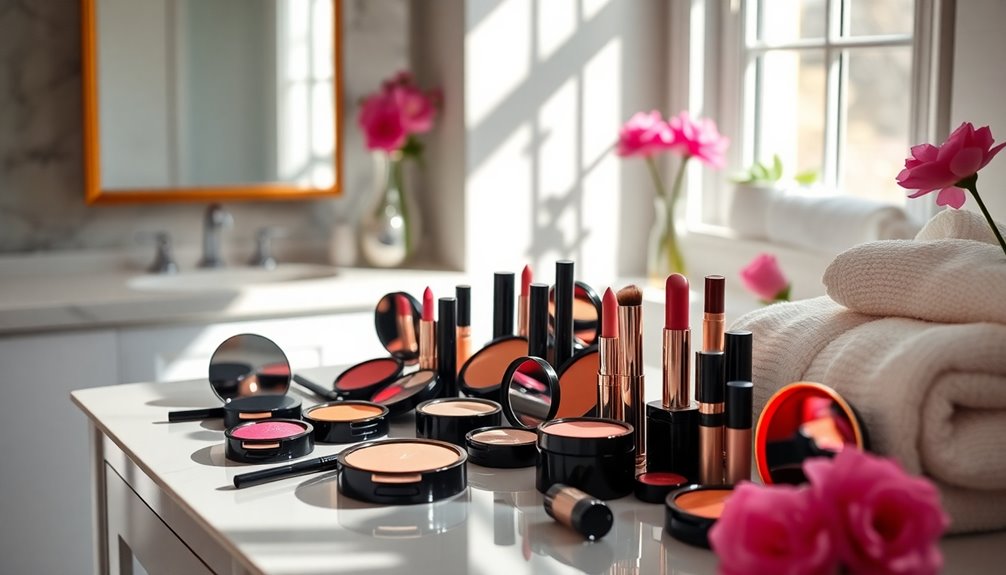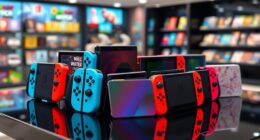Kering’s CEO promises a swift reset after selling its €4 billion beauty division to L’Oréal, signaling a focus on core fashion brands like Gucci and Saint Laurent. This move aims to reduce debt, stabilize finances, and streamline operations. The sale shifts attention away from underperforming segments and toward strategic growth in luxury fashion. If you keep exploring, you’ll uncover how this change impacts the industry and what it means for both companies’ futures.
Key Takeaways
- Kering’s CEO commits to a strategic reset following the €4 billion sale of its beauty division.
- The sale signals a focus shift toward core fashion brands like Gucci and Saint Laurent.
- The divestment aims to stabilize financial health and reduce debt, enabling faster strategic realignment.
- Kering plans to sharpen its focus on luxury fashion, abandoning underperforming beauty and fragrance segments.
- The deal facilitates a swift transformation to strengthen Kering’s market position and operational efficiency.

Kering’s CEO has pledged a swift reset after selling its €4 billion beauty division to L’Oréal, signaling a strategic shift to focus on its core fashion brands. This move underscores Kering’s commitment to refining its business and addressing recent challenges. Since launching its beauty division in 2023, Kering aimed to diversify, acquiring Creed for around €3.5 billion and expanding into luxury fragrances. However, this expansion didn’t meet expectations; the division posted a €60 million operating loss in the first half of 2025, and sales at brands like Gucci and Saint Laurent faced decline. Realizing the need for a sharper focus, Kering decided to exit the beauty market, selling its division to L’Oréal for €4 billion. This sale not only provides a substantial cash infusion but also helps reduce Kering’s debt, which stood at about €9.5 billion in June 2025. This strategic move was driven by recent operational challenges and the need for financial stabilization. Additionally, this decision reflects a growing trend among luxury brands to prioritize user profile management for better financial health.
Kering exits beauty to focus on core fashion brands, reducing debt and streamlining operations after recent underperformance.
This strategic shift is a clear signal to the market that Kering aims to streamline its operations. By divesting from beauty, the company can allocate resources more effectively toward strengthening its fashion powerhouse. The deal includes a long-term strategic partnership, with L’Oréal acquiring exclusive 50-year licenses to develop and distribute fragrances and beauty products for Gucci, Bottega Veneta, and Balenciaga. Additionally, L’Oréal’s acquisition encompasses Creed, bolstering its presence in high-end fragrances. The transaction is expected to close in the first half of 2026, and the partnership features a joint venture focused on wellness products, reflecting a broader industry trend toward health and longevity.
For L’Oréal, the acquisition marks its largest in over a century and considerably expands its luxury portfolio. As the largest dedicated cosmetics and beauty company globally, L’Oréal gains control over high-margin fragrance markets and strengthens its European market share. This move positions L’Oréal to compete more aggressively in the luxury segment and offers opportunities to innovate in wellness and longevity, aligning with emerging consumer preferences.
Meanwhile, Kering’s decision highlights the difficulties faced by luxury conglomerates trying to diversify into beauty. The sale allows Kering to stabilize its financials and sharpen its strategic priorities. The company aims to stabilize its EBITDA at around €3.6 billion in 2025, focusing on core fashion brands like Gucci and Saint Laurent. The move also signals a broader industry trend where luxury groups reassess their portfolios to pursue growth within their primary strengths.
Ultimately, this deal reshapes the competitive landscape of the luxury beauty market, giving L’Oréal a substantial foothold in high-end fragrances and enabling Kering to concentrate on its core strengths. Both companies are positioning themselves for future growth, with Kering aiming to rebound through its fashion brands and L’Oréal expanding its luxury beauty footprint. This strategic reset indicates a new chapter for both, driven by a clear focus on their respective core competencies.
Frequently Asked Questions
What Specific Strategies Will Kering Implement for the Reset?
You’ll see Kering focus on its core fashion brands like Gucci and Saint Laurent to revitalize growth. They plan to reduce debt with proceeds from the €4 billion sale, aiming for a healthier financial position. Additionally, they’ll form long-term licensing partnerships with L’Oréal to expand luxury beauty and wellness. This strategic shift is designed to boost performance, restore investor confidence, and strengthen their leadership in the luxury fashion market.
How Will the Beauty Deal Impact Kering’s Overall Brand Portfolio?
Think of Kering’s brand portfolio as a garden. With the beauty deal, you’re pruning away the less essential flowers, allowing the main ones—fashion and leather goods—to flourish. This shift sharpens your focus, boosting brand strength and market presence. You’ll see more targeted investments, innovative collaborations, and a clearer identity. Ultimately, your portfolio becomes a more vibrant, cohesive landscape, attracting attention and elevating the luxury experience for consumers.
What Timeline Is Expected for the Reset Process Completion?
You can expect the reset process to be completed by mid-2026, around the time the €4 billion beauty deal closes. During this period, you’ll see immediate actions like cost reductions, debt reduction, and brand license transfers. Kering will focus on streamlining operations, reallocating resources to core fashion brands, and implementing strategic initiatives. The timeline includes phased shifts for beauty licenses, with full stabilization anticipated shortly after the deal’s closure.
Are There Any Potential Risks Associated With the Reset Plan?
You should be aware that risks could threaten your reset plan’s success. Operational challenges may arise from brand *changes*, especially with Creed moving to L’Oréal. Market volatility and fluctuating demand for luxury goods could impact sales and profits. There’s also a risk of execution issues, like failing to manage store closures or job cuts effectively. Regulatory hurdles and integration complexities might further delay or complicate your strategic restructuring efforts.
How Will This Reset Affect Kering’s Market Share in Luxury Sectors?
This reset could help you regain market share in luxury sectors by sharpening focus on core fashion and accessories brands. As Kering simplifies its portfolio, you’ll see improved brand clarity and stronger positioning against competitors. However, external headwinds like market softness and L’Oréal’s growing beauty presence might challenge growth. Overall, strategic revitalization and innovation are essential for you to capitalize on new opportunities and strengthen your market position.
Conclusion
You might think this quick reset signals chaos, but it’s actually a smart move to stay agile. Kering’s leadership knows that adapting fast keeps them ahead, especially after such a huge deal. So, don’t worry—this isn’t a sign of trouble, but a sign they’re ready to seize new opportunities. With their eyes on the future, you can trust they’ll turn this reset into even greater success.










